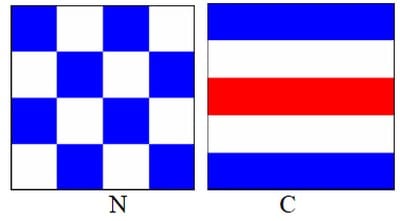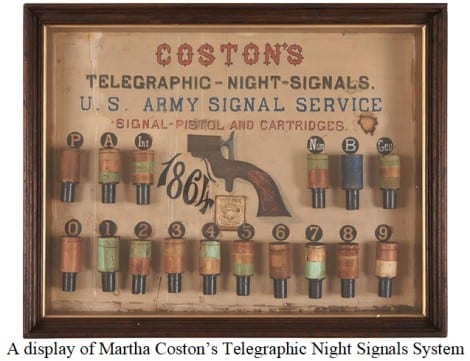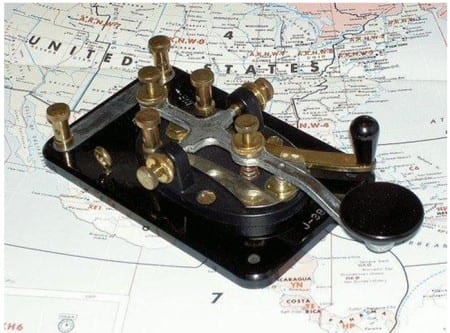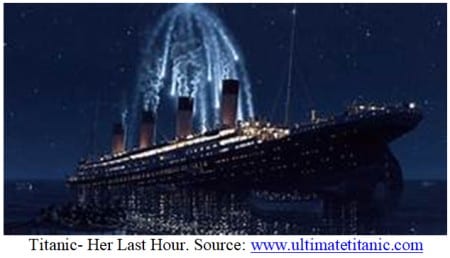 By Bob Currie, Recreational Boating Safety Specialist
By Bob Currie, Recreational Boating Safety Specialist
U. S. Coast Guard Auxiliary Base Galveston Flotilla
Sailing, sailing, over the bounding main;
For many a stormy wind shall blow, ere Jack comes home again!
The song chorus above is widely known and appears in many children’s songbooks. It appears in Disney cartoons as well. It is a very upbeat song written in 1880. It is an appropriate lead-in to this column, as today we will discuss distress signals for boats that travel offshore rather than inshore, where most recreational boaters limit their range. Whether Jack gets home again or not often depends upon the distress signals used by his ship.
The Base Galveston Flotilla of the US Coast Guard Auxiliary operates out of the US Coast Guard base on Galveston Island. They aid the Coast Guard by providing maritime observation patrols in Galveston Bay; by providing recreational boating vessel safety checks; and by working alongside Coast Guard members in maritime accident investigation, small boat training, providing a safety zone, Aids to Navigation verification, cooking in base and station galleys and aboard cutters; and as drone pilots on the Coast Guard Drone Team.
History of Flags as Distress Signals for Ships at Sea
The earliest distress signals for ships at sea were flag signals. The process was quite simple: simply invert and fly your national ensign. An upside down flag is still a distress signal today, both at sea and on land. Today the international maritime signal flags NC (November Charlie), flown together, indicate distress.

History of Pyrotechnics as Distress Signals for Ships at Sea
Pyrotechnics, which include rockets, have been around for hundreds of years. Most people think of them as a visual distress signal, but under the International Rules of the Road governing Signals of Distress the signal rockets were not a visual distress signal; instead, the signal rockets carried an explosive charge designed to act as an audible distress signal. Most people have read or heard that the master of the Californian saw the Titanic’s distress signals and failed to come to the rescue. The problem is that the socket rockets fired by the Titanic did not meet the requirements of the 1912 International Rules of the Road for Distress Signals; the Rules of the Road specified that a cannon (or explosive report) fired at one minute intervals constituted a distress signal. Titanic’s socket rockets were fired randomly, with some fired as little as four minutes after the previous rocket, and some fired as long as eight minutes after the previous rocket. Such random firing, under the Rules of the Road, indicated “stay clear, navigation problem.” Therefore, the Californian did not ignore any distress signals from the Titanic.
A signal flare system was invented by Martha Colston in 1848. She was the 21-year-old widow of an inventor who had been working on inventing a signal flare. Martha found some of her husband’s notes and set about to design and market a signal flare system. She used fireworks technology as the basis for her design. She designed an elaborate system that she named Telegraphic Night Signals. She received a patent for her system in 1859. The U.S. Navy then paid her $20,000 for her patent and then awarded her the manufacturing rights. Her flare system served as the basis for communication that helped save lives and win battles during the Civil War.

History of the Use of Radio for Distress Signals for Ships at Sea
The first uses of radio on ships were by spark-gap transmitters, invented by Guglielmo Marconi during the period of 1894-1895. These radios were called wireless telegraphy. The telegraph system in use prior to the invention of wireless telegraphy used transmitters and receivers connected by wires. The telegraph system was used for sending messages of all sorts, including the use of the system to dispatch trains. Wireless telegraphy never replaced the wired system on land but became the only way to talk over distance between boats and other boats and between boats and land. Spark-gap transmitters transmitted over a very wide frequency, and there was no way to tune them other than by changing the shape and configuration of the antenna. The original system’s receiver did not convert the electronic pulses to audible beeps. Instead, they produced ink marks on a white tape that were interpreted by the receiving radio operator.
The first naval use of the spark-gap wireless radio was ship-to-ship for reporting enemy ship locations. The military had the first uses. The second use was to send and receive messages from land when a ship was in range of a land based station.
The next evolution of the wireless transmitter was the invention by Marconi of a magnetic detector coupled with the use of headphones. The magnetic detector was more sensitive and signals could be transmitted and received much faster due to the elimination of the ink printer previously used. Codes consisting of two to three letters were used to convey many messages. A common code in the early days (and still used today) was CQ, which meant “All stations.” In order to form a recognized distress signal, the letter D (for distress) was added, making CQD the first official distress signal for wireless transmissions.

Before the Titanic sank in 1912, a new distress signal was added under the 1912 Rules of the Road: SOS. Contrary to popular belief, SOS didn’t stand for anything- it was simply used because of the simplicity of the letter codes and for their ease of recognition. Titanic didn’t sink quickly; instead, it floated for hours, and many radio distress signals were sent out. The Titanic radio operator initially used only the CQD code; however, he asked the captain about using the new code, and the captain said you might as well use both, since you may never have a chance of using them again. Although the Californian was in radio range of the Titanic, the Californian did not have a night radioman. Their radio was unmanned during the time that the Titanic was sinking. One of the outcomes of the investigation was that ships had to always man their radios.
Modern Distress Signals for Recreational Boaters
It has been 109 years since the tragic loss of the Titanic. The distress signals of that time were flags, pyrotechnics, and radio. Titanic could have had all of its passengers and crew saved rather than the small percentage that were saved had they made proper use of their pyrotechnic signals and had there been a requirement in place for all ships at sea to always monitor their radios for distress signals. The same thing applies to modern times: many persons lost at sea could have been saved had they used the distress signals available: flags, pyrotechnics, and radio. That’s right- the distress signal categories are still the same: flags, pyrotechnics, and radio.
Recreational boaters operating in inland waters are required to have flags and pyrotechnics, but there is no requirement for having a radio when operating in inland waters. The Code of Federal Regulations defines inland waters. For us operating in the Gulf of Mexico, the regulation defines inland waters as: “A line drawn from Marquesas Keys, Florida at approximate position latitude 24°47.5′ N, longitude 82°11.2′ W; along the 12-mile line which marks the seaward limits of the territorial sea (as defined in 33 CFR 2.22(a)(1)) to Rio Grande, Texas at approximate position latitude 25°58.6′ N, longitude 96°55.5′ W.” If we wanted to paraphrase that regulation, we could say that in our area, the Gulf of Mexico, inland waters extend to 12 miles out; after that, you are operating seaward.
Help the Coast Guard Save You
In my experience as a Coast Guard Vessel Examiner, about two thirds of recreational boaters know they are supposed to have visual distress signals. About 70 percent of those who know they are supposed to have visual distress signals actually have the minimum required signals. If you do the math, that means that less than half of the recreational boaters have the required visual distress signals on their boats.
It always amazes me that people will spend $100 on ice and beer per trip but will not spend $40 for visual distress signals that last 42 months. Although that shiny can of beer might be used to signal for help during daylight hours, when the sun goes down you are out of luck if you have no pyrotechnics. If you see yourself in this description, do you and your passengers a favor and get some visual distress signals. They may possibly save your life and will certainly save you a $250 fine if you are stopped for a safety check and don’t have them.
A radio! A radio! My kingdom for a radio!
That isn’t quite what King Richard III yelled in the Shakespearean play, but the intent is the same. His life hangs in the balance due to the loss of his horse, and he would give everything he has to have such an insignificant item as a horse. The phrase still exists today as an expression of need for an insignificant item to get one out of a jam. If you find yourself disabled on the water and no other boats are near, the best and most-long-range pyrotechnics will not save you. You need a radio. In our case I am talking about a VHF/Marine radio. If you are operating within 20 miles of shore, the Coast Guard guarantees that they can hear and respond to a radio distress signal anywhere along the US coast. It’s called the Rescue 21 System. I have operated it as a Coast Guard watchstander. We can triangulate your position with a single click of your radio on Channel 16. You can purchase a handheld VHF/Marine radio for less than $100.
For longer distances than 20 miles, you need a different type of radio such as a Personal Locator Beacon (PLB) or an Emergency Position Indicating Beacon (EPIRB). These devices operate by sending an emergency signal to a satellite when activated. When properly registered with NOAA, your personal information (name, boat, etc.) are sent to the Coast Guard along with your position and help is soon on the way. Can’t get that with a can of beer.
Summary
Over 100 years ago there were flag, pyrotechnic and radio distress signals available for ships at sea. Those same categories of distress signals are still in use today. Even then the radio was the safest and most successful of the available distress signals. Although the Coast Guard doesn’t require recreational boaters to have a radio capable of issuing a distress signal, the VHF/Marine radio represents the only type of distress signal with a guarantee that your distress signal will be received and acted upon.
For more information on boating safety, please visit the Official Website of the U.S. Coast Guard’s Boating Safety Division at www.uscgboating.org. Questions about the US Coast Guard Auxiliary or our free Vessel Safety Check program may be directed to me at [email protected]. I am available to perform free Vessel Safety Checks, and I will come to your location to perform them. SAFE BOATING!
[June-8-2021]


 Posted in
Posted in 























